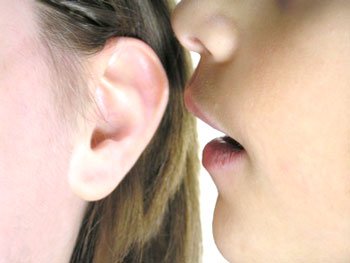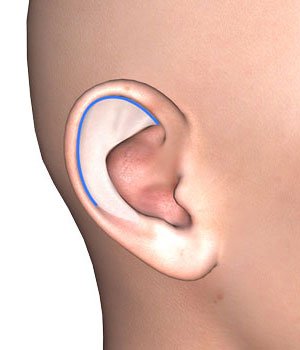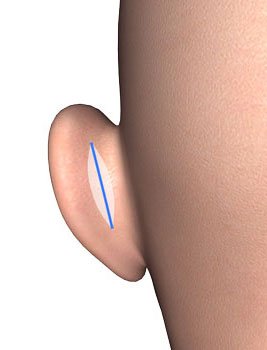
Ear correction for protruding ears can be performed using various techniques. Over 170 methods have been published in the literature. Most otopexy techniques involve a skin incision behind the ear. There are fewer methods with an incision on the front of the ear and so-called suture techniques or folding techniques that do not require an incision. Below you will find a summary of the most important techniques:
Description of older ear correction techniques
- Ear correction according to Ely (1881):
In the ear correction technique he described, Ely removed a spindle-shaped part of the pinna and fixed the pinna using a mastoid suture. The mastoid is the mastoid process, a part of the skull bone behind the ear, which is used for fixation in a whole range of methods. - Method according to Keen (1889):
This method was the first to achieve ear placement by modeling the so-called anthelix (middle ear fold). - Method according to Morestin (1903):
His ear correction method was also slightly modified in the same way as Ely. A piece of cartilage was cut out for shaping. - Goldstein technique (1908):
Goldstein fixed the cartilage of the auricle (concha) to the periosteum (of the mastoid) without removing any cartilage. This is known today as auricular rotation = concharotation. - Operation according to Luckett (1910):
Removed a spindle-shaped piece of cartilage from the auricle and sutured the edges of the cartilage together in such a way that when the ear was closed, it lay flat and formed an anthelix fold. - Technique according to Davis and Kitlowski (1937):
They were the first to describe the use of needles soaked in paint to mark the anthelical fold to be formed. This is still widely practiced today.
Pictures:
- The anterior approach is less popular, but just as practical. The scars on the front are practically invisible when sutured with fine stitches.
Blue line = scar progression; brightening = area of cartilage exposure. - Here you can see the most frequently used approach for ear correction.
Blue line = scar progression; lightening = excess skin that is removed.
What newer ear correction methods are available?
The new ear correction methods are based on the above-mentioned techniques with the aim of refinement through modification. They developed particularly after the Second World War.
- MacCollum method (1938):
MacCollum was the first to combine the shaping of the anthelix and the suture between the auricle and the periosteum on the skull bone. - McEvitt (1947), Converse (1955), Erich (1958):
The principle of this ear correction involves weakening the cartilage on the back. - Ear correction according to Mustardé (1963):
In the case of soft ear cartilage, Mustardé did not thin out the cartilage and only used so-called mattress sutures. - Technique according to Ju et al (1963):
The special feature of this method is the incision on the front of the auricle (see illustration), which allows precise scoring of the cartilage from the front. - Op according to Chongchet (1963):
Weakening of the cartilage on the front side by means of many small incisions. - Ear correction according to Stenström (1963):
Rasping (in contrast to Chongchet) on the front of the auricle with incision from the back. - The thread method is a folding technique without cutting. Depending on the operation and findings, the stitches may not need to be removed at all. Further details on this form of ear correction can be found under Suture method / Folding technique.
Detailed information on ear placement:
Today, the surgeon should know the most important methods of ear correction in order to be able to apply and combine them depending on the findings of the ear malposition.
- Before deciding to undergo ear pinning surgery, you should obtain detailed information on the topic of ear correction. Further information including the procedure, pre- and post-treatment, anesthesia and much more can be found in our overview article on the topic of ear surgery.
- It is also possible to correct protruding ears without operating on them. However, this is subject to very strict conditions. You can find more information on this in the article on ear pinning without surgery.
- Protruding ears are sometimes associated with so-called macrotia (ears that are too large). If desired, this deformity can be corrected as part of the operation. You will find more information on this special topic in the article Ear reduction.
- If the prominent ears are also combined with a malformation of the earlobes, an additional earlobe correction can be performed.
Sources:
- Current trends in otoplasty. – Petersson RS, Friedman O. – Curr Opin Otolaryngol Head Neck Surg. 2008 Aug;16(4):352-8
- Goals of otoplasty for protruding ears:
Goals in otoplasty for protruding ears. – McDowell AJ. – Plast Reconstr Surg. 1968 Jan;41(1):17-27. - The treatment of prominent ears by buried mattress sutures: a ten-year survey. – Mustarde JC. – Plast Reconstr Surg 39(4):382-6 (1967 Apr)
- Surgery of the auricle – Hilko Weerda – Thieme – 2004



